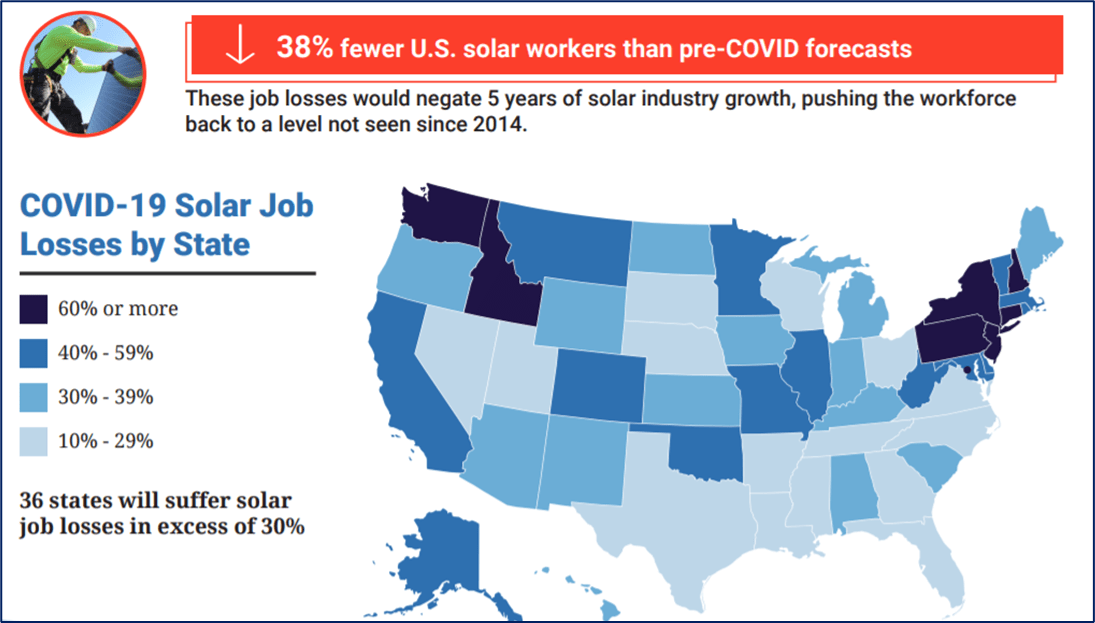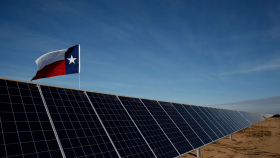The solar industry is among the seemingly endless number of industries being pummeled by the economic fallout brought on by the COVID-19 pandemic, but with collective action, the industry will showcase its resilience and get back to its old ways of growth.
Mounting Economic Impacts
There’s no use in sugarcoating the scale of the disruption that the COVID-19 situation has inflicted on the solar industry. The suddenness and depth of the downturn are unlike anything the industry has ever gone through before. The Solar Energy Industries Association (SEIA) – the industry’s premier trade association – now anticipates that 38% fewer people will be employed in the U.S. solar industry through June. The SEIA estimates that just 188,000 people will be working in the industry by then as opposed to the 302,000 they projected earlier in the year pre-COVID. The anticipated amount of installed solar capacity has also been cut drastically by the SEIA with the group now expecting just 3 GW of solar capacity to be installed in Q2 2020, a decrease of 37% from pre-COVID forecasts.
Photo Source: SEIA
Unemployment figures provided by the Bureau of Labor Statistics paint a similarly bleak picture for the broader “clean energy” sector. Over 447,000 people in the sector filed for unemployment in April alone. Total unemployment claims from March and April total up to 594,347 people, or 17.8% of the sector’s total workforce.
Southern States Positioned to Weather the Storm
The SEIA estimates that every state in the country will suffer losses in the solar industry as a result of the COVID-19 pandemic. The impact, however, in the South is expected to be noticeably less pronounced than in the rest of the country.
As noted in a previous Solar Tribune piece, 5 Southern states were listed among the top 10 states to add solar jobs from 2018-2019 – showcasing the region’s growing strength. Similarly, the SEIA projects that 8 of the 10 states likely to suffer the least in terms of the percentage of solar jobs lost due to COVID-19 are located in the South.
Image Source: Table created by Solar Tribune using SEIA data
The region’s ability to weather the COVID-19 storm better than any other geographic area of the U.S. is owed in part to the strength of the region’s solar industry going into the COVID-19 pandemic. The 15 states comprising the South (as defined by the SEIA) accounted for over 26% of the nation’s cumulative solar capacity (MW) in 2019. Moreover, the South accounted for just under 55% of all net job growth nationally from 2018 to 2019 in the solar industry. COVID-19 is sure to test the durability of these impressive growth numbers.
One major advantage that many Southern states will have working in their favor as they attempt to survive the downturn is the outsized role that large utility-scale projects play in many of these states. Utility-scale projects have ramped up significantly in the South in recent years. The Energy Information Administration (EIA) notes that since 2017, no region of the country has installed more new utility-scale solar than the South Atlantic region (see map graphic below).
Image Source: EIA
Favorable state regulations and renewable portfolio standards (RPS) are main drivers of the utility-scale solar boon in the South. As the EIA puts it:
“Growth in South Atlantic solar generating capacity has been driven by state government programs and policies in North Carolina, Florida, Georgia, and South Carolina. These state programs and policies encourage large-scale installation of renewable energy technologies such as solar PV.”
The dominant role that utility-scale solar plays in many Southern states provides a degree of stability in the industry at a time when uncertainty is otherwise running rampant.
Unlike residential solar, utility-scale projects have long project timelines with projects being installed today having most likely been approved years ago. The declaration of construction jobs as “essential business” in most states has allowed these solar projects to largely continue unaffected by the halting impacts of the virus. Utility-scale projects don’t require a significant number of workers to install or maintain them, so job losses are naturally going to be more acute in the labor-intensive residential and commercial space. The total open-air environment that utility-scale projects are built under and the sheer expansiveness of the projects also lend themselves much better to social distancing protocols as compared to residential projects that require more frequent customer interactions.
To be fair, economic impacts in the utility-scale solar sector are likely just a lagging indicator and we are sure to see more noticeable signs of distress in the sector later this year. Hopefully the residential and commercial solar sectors will be on the rebound by then to help buoy the broader industry.
An Uncertain Future Ahead
With so much uncertainty swirling around the solar industry, the industry’s ability to get back on its feet in the near-term may rest primarily in the hands of policymakers on Capitol Hill.
None of the federal relief packages passed through Congress to-date have included solar industry-specific relief. Recognizing that some sort of financial relief may be necessary to spark a swift recovery in the industry, the SEIA and other solar stakeholders are lobbying hard for Congress to pass legislation that encourages the desperately needed flow of capital back into solar projects. Allowing for full utilization of the federal Investment Tax Credit (ITC) and “direct pay” from the U.S. Treasury to homeowners of solar projects that help to bridge the financing gap that has emerged due to a constricting tax equity market are among the SEIA’s top priorities. A recent survey of solar company representatives conducted by the SEIA showed that 63% of respondents are concerned they can’t get access to tax equity – a pivotal aspect that many solar projects rely on. Read more here about the public policy priorities the SEIA is advocating for in an effort to mitigate the harsh impacts the current economic downturn has brought to the solar industry.
In the absence of meaningful federal action, the SEIA and partnering organizations have worked with state and local governments to innovate and allow for the vital solar permitting process to shift to virtual platforms. In a recent interview, Abby Hopper, President/CEO of the SEIA noted:
“We have really accelerated online permitting, instant permitting, remote permitting. Actually, I am hopeful (that) will continue past this crisis and make that process much more efficient.”
It’s still clear that much more needs to be done to get the solar industry back on its pre-COVID upward trajectory.
Consult the SEIA’s COVID-19 Resources page to learn more about the resources available to help solar companies in this uncertain time and to better understand the advocacy work being undertaken to push for the passage of pro-solar relief policies. This is a challenging time for the solar industry, but there is reason to be hopeful that the industry can overcome the current economic headwinds and get back to its thriving ways. The renewables sector needs to play a staring role in leading our nation’s economic recovery. Let’s make it happen.
Cover Photo Source: LA Times








